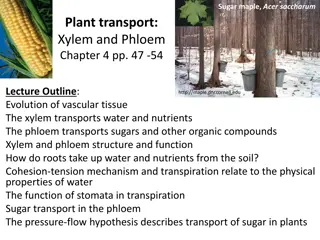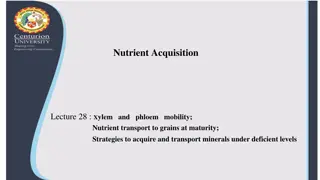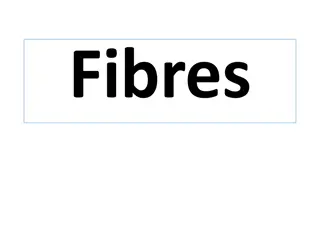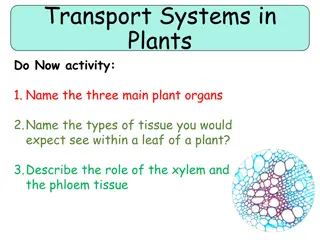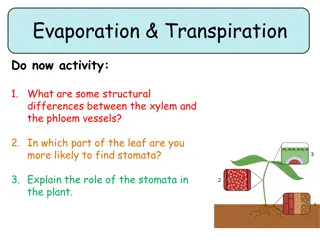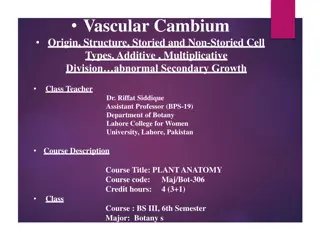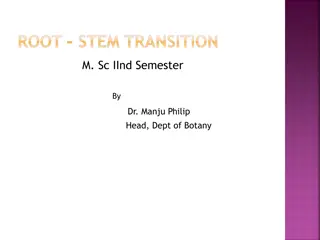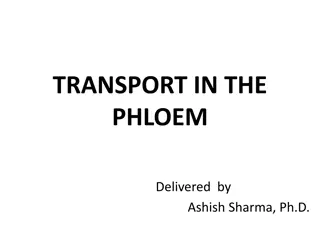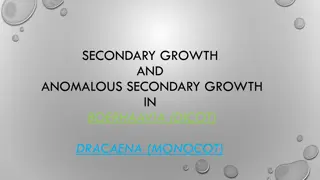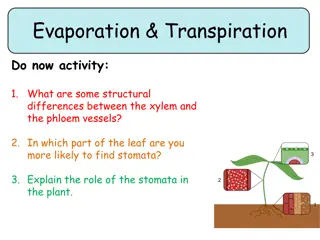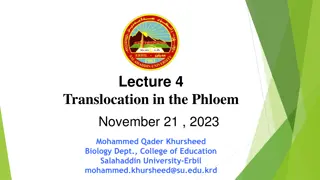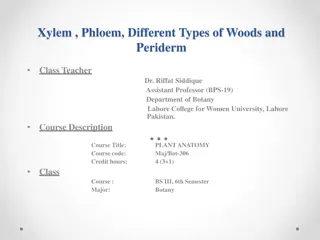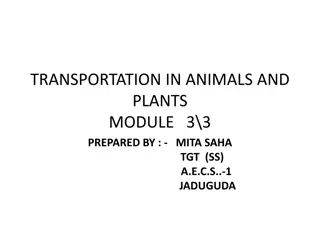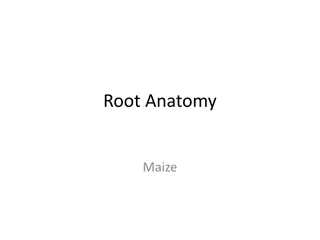Understanding Plant Transport Systems: Xylem and Phloem
Explore the intricate system of plant transport through xylem and phloem, from how roots absorb water to the pressure-flow hypothesis in sugar transport. Learn about the evolution, structure, and function of vascular tissues and the critical role of transpiration. Dive into the classification of pla
3 views • 27 slides
Nutrient Acquisition
Plants utilize xylem and phloem to transport water, nutrients, and minerals throughout their structures. Xylem moves water and mineral salts from roots to leaves, while phloem transports sugars and amino acids from leaves to the rest of the plant. Nutrient acquisition involves passive and active tra
2 views • 6 slides
Understanding Plant Transport Systems: Xylem, Phloem, and Transpiration
This comprehensive lecture outline delves into the intricate mechanisms of water and nutrient transport in plants. Topics covered include the roles of xylem and phloem, root water uptake processes, cohesion-tension mechanism, transpiration, stomatal function, sugar transport in phloem, and the press
4 views • 23 slides
Understanding Fibres: Types, Classification, and Identification
Fibres are vital materials used in various industries. They are classified into natural, artificial, and synthetic categories based on their source. Differentiation of fibres occurs in pericyclic, phloem, and xylem regions. Identification involves microscopical examination, physical tests, and chemi
2 views • 30 slides
Understanding Plant Transport Systems: Organs, Tissues, and Functions
Explore the key components of plant transport systems including organs, tissues, and the roles of xylem and phloem in transporting water, sugars, and minerals essential for plant life. Engage in activities, assessments, and a video to deepen your understanding.
0 views • 14 slides
Understanding Plant Evaporation and Transpiration Processes
Learn about the structural differences between xylem and phloem vessels, the role of stomata in plant leaves, and how water loss occurs through transpiration. Discover how guard cells regulate stomata openings and watch a video explaining transpiration processes in plants. Test your knowledge with s
0 views • 11 slides
Understanding Vascular Cambium in Plant Anatomy
Vascular cambium is a crucial growth layer in stems and roots, responsible for producing xylem and phloem in plants. It originates from the maturation of procambium cells, differentiating into storied and non-storied cell types. It plays a vital role in secondary growth by generating new wood in woo
0 views • 26 slides
Understanding Vascular Transition in Root-Stem Structure
Root and stem in plants form a continuous structure with a transition region between them. The transition involves twisting and inversion of xylem strands, leading to variations in vascular bundles. Eames and Mac Daniels identified different types of vascular transitions in dicots and monocots, each
1 views • 13 slides
Transport in the Phloem: A Detailed Overview by Ashish Sharma, Ph.D.
The phloem plays a vital role in transporting sugars and organic materials throughout plants. This system involves various specialized cells like sieve elements, companion cells, parenchyma cells, and phloem fibers. Mature sieve elements lack certain organelles and have non-lignified cell walls, mak
7 views • 32 slides
Understanding Secondary Growth in Plants: Boerhaavia (Dicot) vs. Dracaena (Monocot)
Secondary growth, resulting from cambial cell division, thickens stems and roots in plants. This process involves cambium, a tissue layer between xylem and phloem, responsible for secondary growth. Cambium ray initials give rise to vascular rays and secondary xylem/phloem. The seasonal activity of c
0 views • 24 slides
Understanding Transpiration Process in Plants
Explore the intricate process of transpiration in plants, focusing on the roles of stomata, guard cells, and water movement. Learn about the structural differences between xylem and phloem vessels, stomata's function in regulating gas exchange, and how environmental factors impact transpiration rate
0 views • 14 slides
Understanding Translocation in the Phloem
This lecture explores the process of translocation in the phloem, supported by evidence from studies such as aphid experiments, ringing experiments, and the use of radioactive isotopes. It delves into the materials translocated in phloem sap, including water, sucrose, non-reducing sugars, nitrogen c
5 views • 18 slides
Exploring the Wonders of Cinnamon Bark and Its Uses
Cinnamon bark, derived from Cinnamomum zeylanicum trees, is a revered spice known for its aromatic qualities. The powder showcases light brown or yellowish-brown color with a sweet taste. Microscopically, it contains phloem fibers, sclereids, and parenchyma fragments. This versatile ingredient serve
2 views • 8 slides
Understanding Xylem, Phloem, and Vascular Bundles in Plant Anatomy
Exploring the intricate structures of xylem and phloem, essential components of plant vascular bundles. Discover the functions and components of xylem, including tracheides and vessels, as well as the patterns of secondary thickening. Learn about the roles of phloem in transporting nutrients through
0 views • 33 slides
Understanding Transportation in Animals and Plants Module
This module explores the transportation processes in plants, focusing on how water and nutrients are absorbed through roots, the role of root hairs, vascular tissue, xylem and phloem in transporting substances, and the important process of transpiration in cooling and water release. It highlights th
0 views • 8 slides
Maize Root Anatomy: An In-depth Examination
Maize root anatomy involves various specialized structures such as the epidermis, cortex, endodermis, pericycle, and vascular tissue. The epidermis is crucial for absorption and protection, while the cortex plays a role in providing support and storage. The endodermis acts as a barrier and regulates
0 views • 9 slides
Understanding the Anatomy and Functions of Plant Stems
Plant stems play a crucial role in the growth and survival of plants. They transport water, minerals, and sugars, support leaves and flowers, and store food. The outer structures of stems, such as buds and nodes, are essential for plant growth. Furthermore, the tissues inside the stem, including xyl
0 views • 12 slides
